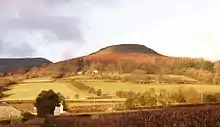Crug Hywel
Crug Hywel (sometimes called the Table Mountain in English) is a flat-topped mountain at the southern edge of the Black Mountains in south-east Wales. It rises to 451 m above sea level, from the southern flank of Pen Cerrig-calch (701 m), and overlooks the town of Crickhowell, to which it gives its name.[1] The name is from Welsh crug, a hillock, and hywel, conspicuous.[2]
| Crug Hywel | |
|---|---|
 Crug Hywel, Black Mountains | |
| Highest point | |
| Elevation | 451 m (1,480 ft) |
| Prominence | < 10 m |
| Naming | |
| English translation | Hywel's mound |
| Language of name | Welsh |
| Pronunciation | Welsh: [ˈkriːɡ ˈhɐwɛl] |
| Geography | |
| Location | Black Mountains, Wales |
| OS grid | SO225207 |
Crug Hywel's summit is entirely taken up by an Iron Age Celtic hillfort,[1] with a clearly visible earth and stone ditch and rampart.[3] Crug Hywel is approached by a couple of public footpaths across farmland from Crickhowell and Llanbedr and visited by the Beacons Way. It lies within an area designated as open country over which the public have the right to roam.
Geology

The hill is formed from Old Red Sandstone originating in the Devonian period, specifically the sandstones of the Brownstones Formation, topped by rocks of the Quartz Conglomerate Group. The whole mass of rocks forming this outlier of Pen Cerrig-calch can readily be seen to dip more sharply to the south than nearby strata and is considered to be an excellent example of a translational slide.[4]
See also
References
- "Crickhowell to Table Mountain". Brecon Beacons National Park Authority. Retrieved 22 January 2016.
- Blackie, C. (1887). A Dictionary of Place-Names Giving Their Derivations (3rd ed.). London: John Murray. p. 58.
- "Crug Hywel Camp". Royal Commission on the Ancient and Historical Monuments of Wales. 9 May 2007. Retrieved 22 January 2016.
- Barclay, W.J. & Wilby, P.R. 2003,Geology of the Talgarth district, BGS 1:50K map geological sheet explanation